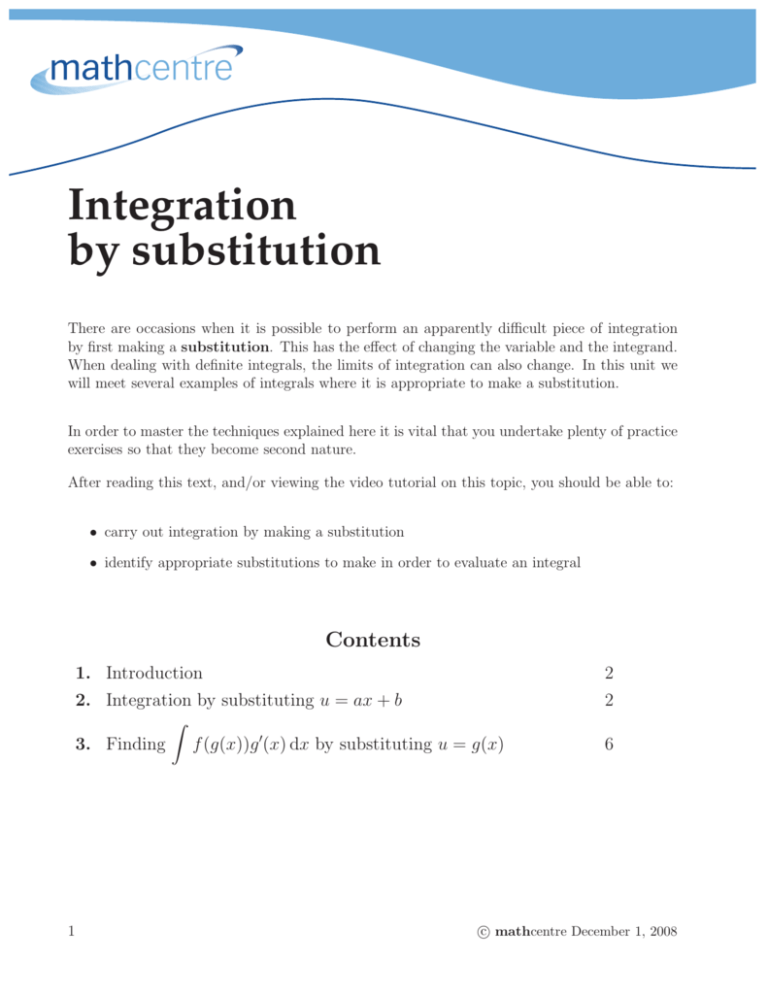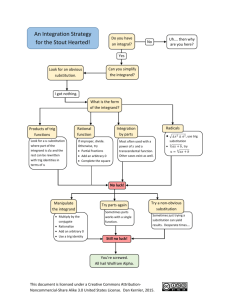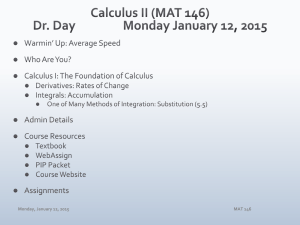Integration by substitution
advertisement

Integration by substitution There are occasions when it is possible to perform an apparently difficult piece of integration by first making a substitution. This has the effect of changing the variable and the integrand. When dealing with definite integrals, the limits of integration can also change. In this unit we will meet several examples of integrals where it is appropriate to make a substitution. In order to master the techniques explained here it is vital that you undertake plenty of practice exercises so that they become second nature. After reading this text, and/or viewing the video tutorial on this topic, you should be able to: • carry out integration by making a substitution • identify appropriate substitutions to make in order to evaluate an integral Contents 1 1. Introduction 2 2. Integration by substituting u = ax + b Z 3. Finding f (g(x))g ′(x) dx by substituting u = g(x) 2 6 c mathcentre December 1, 2008 1. Introduction There are occasions when it is possible to perform an apparently difficult piece of integration by first making a substitution. This has the effect of changing the variable and the integrand. When dealing with definite integrals, the limits of integration can also change. In this unit we will meet several examples of this type. The ability to carry out integration by substitution is a skill that develops with practice and experience. For this reason you should carry out all of the practice exercises. Be aware that sometimes an apparently sensible substitution does not lead to an integral you will be able to evaluate. You must then be prepared to try out alternative substitutions. 2. Integration by substituting u = ax + b We introduce the technique through some simple examples for which a linear substitution is appropriate. Example Suppose we want to find the integral Z (x + 4)5 dx You will be familiar already with finding a similar integral (1) Z u5 du and know that this integral u6 + c, where c is a constant of integration. This is because you know that the rule is equal to 6 for integrating powers of a variable tells you to increase the power by 1 and then divide by the new power. In the integral given by Equation (1) there is still a power 5, but the integrand is more complicated due to the presence of the term x + 4. To tackle this problem we make a substitution. We let u = x + 4. The point of doing this is to change the integrand into the much simpler u5 . However, we must take care to substitute appropriately for the term dx too. In terms of differentials we have du = du dx dx Now, in this example, because u = x + 4 it follows immediately that So, substituting both for x + 4 and for dx in Equation (1) we have Z Z 5 (x + 4) dx = u5 du du = 1 and so du = dx. dx u6 + c. We can revert to an The resulting integral can be evaluated immediately to give 6 expression involving the original variable x by recalling that u = x + 4, giving Z (x + 4)6 +c (x + 4)5 dx = 6 We have completed the integration by substitution. c mathcentre December 1, 2008 2 Example Suppose now we wish to find the integral Z cos(3x + 4) dx (2) Observe that if we make a substitution u = 3x + 4, the integrand will then contain the much simpler form cos u which we will be able to integrate. As before, du = du dx dx and so with u = 3x + 4 It follows that du = du dx du =3 dx and dx = 3 dx So, substituting u for 3x + 4, and with dx = 31 du in Equation (2) we have Z Z 1 cos(3x + 4) dx = cos u du 3 1 = sin u + c 3 We can revert to an expression involving the original variable x by recalling that u = 3x + 4, giving Z 1 cos(3x + 4) dx = sin(3x + 4) + c 3 We have completed the integration by substitution. Z It is very easy to generalise the result of the previous example. If we want to find cos(ax+b)dx, Z 1 1 1 cos u du which equals sin u+c, that is sin(ax+b)+c. the substitution u = ax+b leads to a a a Z 1 A similar argument, which you should try, shows that sin(ax + b)dx = − cos(ax + b) + c. a Key Point Z 3 1 sin(ax + b)dx = − cos(ax + b) + c a Z cos(ax + b)dx = 1 sin(ax + b) + c a c mathcentre December 1, 2008 Example Suppose we wish to find Z 1 dx. 1 − 2x We make the substitution u = 1 − 2x in order to simplify the integrand to u1 . Recall that the integral of u1 with respect to u is the natural logarithm of u, ln |u|. As before, du = du dx dx and so with u = 1 − 2x and du = −2 dx It follows that du = du dx = −2 dx dx The integral becomes Z 1 u 1 − du 2 Z 1 1 = − du 2 u 1 = − ln |u| + c 2 1 = − ln |1 − 2x| + c 2 1 dx, the The result of the previous example can be generalised: if we want to find ax + b Z 1 1 1 du which equals ln |ax + b| + c. substitution u = ax + b leads to a u a Z 1 This means, for example, that when faced with an integral such as dx we can imme3x + 7 1 diately write down the answer as ln |3x + 7| + c. 3 Z Key Point Z c mathcentre December 1, 2008 1 1 dx = ln |ax + b| + c ax + b a 4 A little more care must be taken with the limits of integration when dealing with definite integrals. Consider the following example. Example Suppose we wish to find 3 Z (9 + x)2 dx 1 We make the substitution u = 9 + x. As before, du dx du = dx and so with du =1 dx u = 9 + x and It follows that du = du dx dx = dx The integral becomes Z x=3 u2 du x=1 where we have explicitly written the variable in the limits of integration to emphasise that those limits were on the variable x and not u. We can write these as limits on u using the substitution u = 9 + x. Clearly, when x = 1, u = 10, and when x = 3, u = 12. So we require Z u=12 2 u du = u=10 1 3 u 3 12 10 1 = 123 − 103 3 728 = 3 Note that in this example there is no need to convert the answer given in terms of u back into one in terms of x because we had already converted the limits on x into limits on u. Exercises 1. 1. In each case use a substitution to find the integral: Z Z 1 Z Z 1 3 4 7 (a) (x − 2) dx (b) (x + 5) dx (c) (2x − 1) dx (d) (1 − x)3 dx. 0 −1 2. In each case use a substitution to find the integral: Z Z Z π/2 Z 3x−2 (a) sin(7x − 3)dx (b) e dx (c) cos(1 − x)dx (d) 0 5 1 dx. 7x + 5 c mathcentre December 1, 2008 3. Finding Z f (g(x))g ′ (x) dx by substituting u = g(x) Example Suppose now we wish to find the integral Z √ 2x 1 + x2 dx (3) In this example we make the substitution u = 1 + x2 , in order to simplify the square-root term. We shall see that the rest of the integrand, 2x dx, will be taken care of automatically in the substitution process, and that this is because 2x is the derivative of that part of the integrand used in the substitution, i.e. 1 + x2 . As before, du = du dx dx and so with u = 1 + x2 It follows that du = and du = 2x dx du dx = 2x dx dx So, substituting u for 1 + x2 , and with 2x dx = du in Equation (3) we have Z Z √ √ 2 u du 2x 1 + x dx = Z = u1/2 du = 2 3/2 u +c 3 We can revert to an expression involving the original variable x by recalling that u = 1 + x2 , giving Z √ 2 2x 1 + x2 dx = (1 + x2 )3/2 + c 3 We have completed the integration by substitution. Let us analyse this example a little further by comparing the integrand with the general case f (g(x)) g ′(x). Suppose we write g(x) = 1 + x2 and f (u) = √ u Then we note that the composition1 of the functions f and g is f (g(x)) = √ 1 + x2 . 1 when finding the composition of functions f and g it is the output from g which is used as input to f , resulting in f (g(x)) c mathcentre December 1, 2008 6 Further, we note that if g(x) = 1 + x2 then g ′ (x) = 2x. So the integral Z Z √ 2 is of the form f (g(x)) g ′(x) dx 2x 1 + x dx To perform the integration we used the substitution u = 1+ x2 . In the general case it will be du appropriate to try substituting u = g(x). Then du = dx = g ′ (x)dx. dx Z √ Once the substitution was made the resulting integral became u du. In the general case it Z will become f (u) du. Provided that this final integral can be found the problem is solved. For purposes of comparison the specific example and the general case are presented side-by-side: Z Z √ 2 f (g(x))g ′(x)dx 2x 1 + x dx let u = 1 + x2 du dx = 2x dx du = dx Z Z √ √ 2 2x 1 + x dx = u du let u = g(x) du dx = g ′ (x) dx du = dx Z Z ′ f (g(x))g (x)dx = f (u) du 2 3/2 u +c 3 2 (1 + x2 )3/2 + c 3 Key Point To evaluate Z f (g(x))g ′(x)dx substitute u = g(x), and du = g ′ (x)dx to give Z f (u) du Integration is then carried out with respect to u, before reverting to the original variable x. It is worth pointing out that integration by substitution is something of an art - and your skill at doing it will improve with practice. Furthermore, a substitution which R √ at first sight might seem sensible, can lead nowhere. For example, if you were try to find 1 + x2 dx by letting u = 1 + x2 you would find yourself up a blind alley. Be prepared to persevere and try different approaches. 7 c mathcentre December 1, 2008 Example Suppose we wish to evaluate Z √ 4x dx 2x2 + 1 1 By writing the integrand as √ · 4x we note that it takes the form 2x2 + 1 1 where f (u) = √ , g(x) = 2x2 + 1 and g ′(x) = 4x. u Z f (g(x))g ′(x)dx The substitution u = g(x) = 2x2 + 1 transforms the integral to Z Z 1 √ du f (u) du = u This is evaluated to give Z Z 1 √ du = u−1/2 du u = 2u1/2 + c Finally, using u = 2x2 + 1 to revert to the original variable gives Z 4x √ dx = 2(2x2 + 1)1/2 + c 2 2x + 1 or equivalently √ 2 2x2 + 1 + c Example √ sin x √ Suppose we wish to find dx. x √ Consider the substitution u = x. Then Z du = du dx dx 1 −1/2 x dx 2 1 dx = 2x1/2 1 = √ dx 2 x = so that Z √ Z sin x √ dx = 2 sin u du x from which 2 Z sin u du = −2 cos u + c √ = −2 cos x + c We can also make the following observations: √ 1 the integrand can be written in the form sin x · √ . x c mathcentre December 1, 2008 8 Writing f (u) = sin u and g(x) = Further, f (g(x)) = sin √ √ 1 1 1 x then g ′ (x) = x−1/2 = 1/2 = √ . 2 2x 2 x x. Hence we write the given integral as 2 1 x √ dx 2 x sin Z f (g(x))g ′(x) dx 2 which is of the form √ Z with f and g as given above. √ As before the substitution u = g(x) = x produces the integral Z Z 2 f (u) du = 2 sin u du from which 2 Z sin u du = −2 cos u + c √ = −2 cos x + c Exercises 2 1. In each case the integrand can be written as f (g(x)) g ′(x). Identify the functions f and g and use the general result on page 7 to complete the integration. Z Z Z cos x x2 −5 2 dx. (a) 2xe dx (b) −2x sin(1 − x )dx (c) 1 + sin x 2. In each case use the given substitution to find the integral: Z 2 (a) −2xe−x dx, u = −x2 . Z (b) x sin(2x2 )dx, u = 2x2 . Z 5 √ (c) x3 x4 + 1dx, u = x4 + 1. 0 3. In each case use a suitable Z √ (a) 5x 1 − x2 dx (b) Z x3 √ dx (e) (d) 4 + 16 x Z √ (g) 5x2 1 − x3 dx (h) 9 substitution to find the Z dx √ √ (c) x(1 + x)2 Z cos x (f) (5 + sin x)2 Z ecos x sin x dx (i) integral. Z x4 (1 + x5 )3 dx Z 1 x3 √ dx 4 + 12 x 0 Z esin x cos x dx. c mathcentre December 1, 2008 Answers to Exercises Exercises 1 4651 1 (x − 2)4 +c (b) = 930 4 5 5 (2x − 1)8 (c) + c (d) 4. 16 cos(7x − 3) e3x−2 2. (a) − +c (b) +c (c) 1.382 (3dp) 7 3 Exercises 2 1. (a) 1. (a) (b) (c) (d) 1 ln |7x + 5| + c 7 2 f (u) = eu , g(x) = x2 − 5, ex −5 + c, f (u) = sin u, g(x) = 1 − x2 , − cos(1 − x2 ) + c f (u) = u1 , g(x) = 1 + sin x, ln |1 + sin x| + c. cos(2x2 ) 2 e−x +c (b) − 4 5 2 3/2 3. (a) − (1 − x ) + c (b) 3 1 4 (x + 16)1/2 + c (e) (d) 2 10 (g) − (1 − x3 )3/2 + c (h) 9 2. (a) c mathcentre December 1, 2008 + c (c) 2610 (4sf). 2 1 √ +c − (c) (1 + x5 )4 + c 1+ x 20 1 − + c (f) 0.0707 5 + sin x −ecos x + c (i) esin x + c. 10








